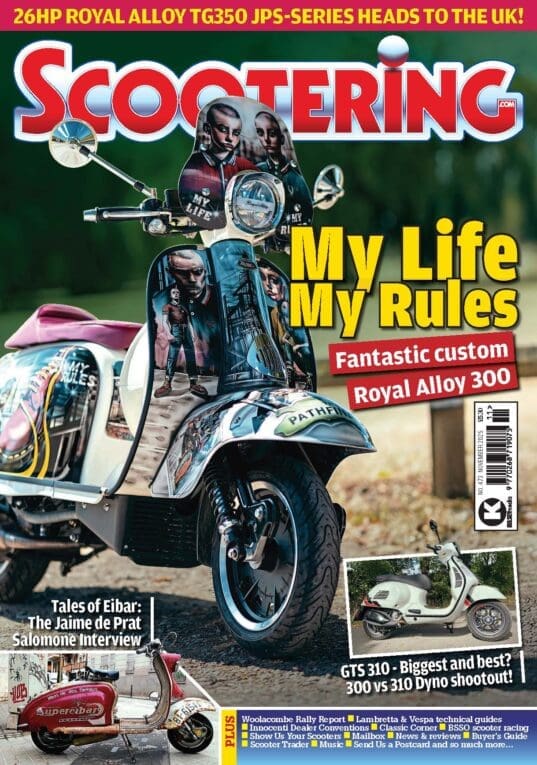Radical, diverse, and possibly a new sub-culture on the scootering scene?
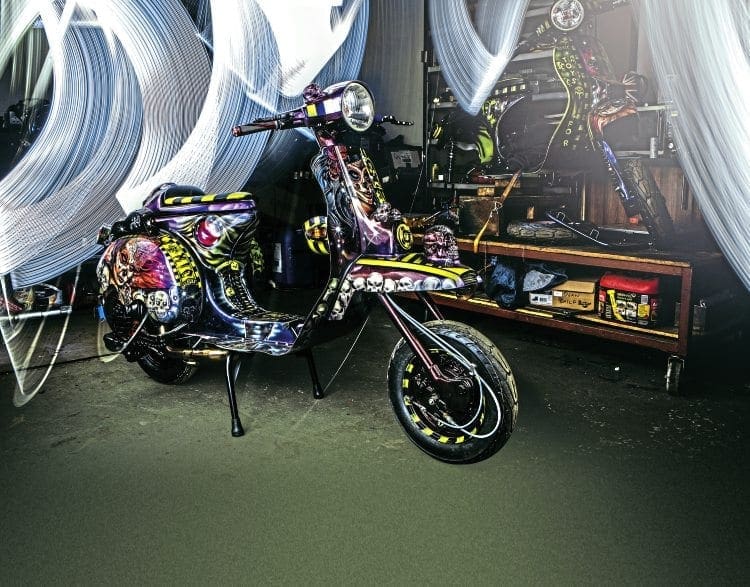
I met Gatch in person at Kev Walsh’s Wicksteed Parts Fair in 2017 – now I could put a face to the name of the infamous ‘Banksy’ of scootering artwork; and little did I know what Gatch and his close team of pals were developing: the ‘Toxic’ series.
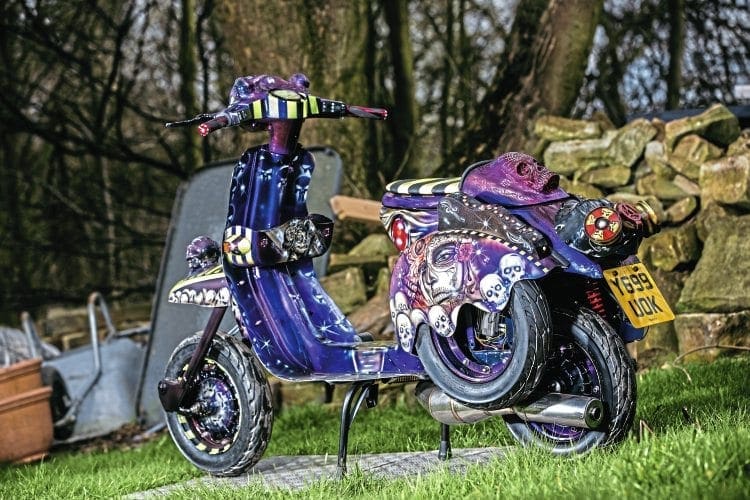
Graffiti
It all started for Gatch back in the early 80s when he saw the work of the young graffiti artists in New York on the sides of trains, buses and in the subways. As Gatch’s interest in street art developed he saw the work of Richard ‘Seen’ Mirando, who remains Gatch’s number one source of inspiration and is still regarded as the ‘godfather of graffiti’.

Gatch isn’t just a talented airbrush artist, he’s also a fabricator of scooters and with his team he’s developed a series of scooters, the Toxic series, which is uncharted. Some will have their own views about the style of Toxic scooters, but it is clear that the team have put together a new and diverse strand for us to consider.

Scooters
Gatch has approximately 12 years of experience applying commissioned artwork to custom scooters of all themes, and this experience has given him the inspiration to take things to another level. Enter the Toxic series. It’s off the grid and controversial, and that’s exactly what Gatch intended to do when he came up with the idea. “I realised it was time to move things on. Every artist needs a signature and I believe I’ve found mine; artwork must be on the move.” Gatch explained, and he’s taken this initiative and run with it.

The Toxic theme starts with Gatch’s interpretation of a topic, which is then turned on its head and given the ‘Toxic treatment’. The ‘treatment’ then runs through the scooter from start to finish.
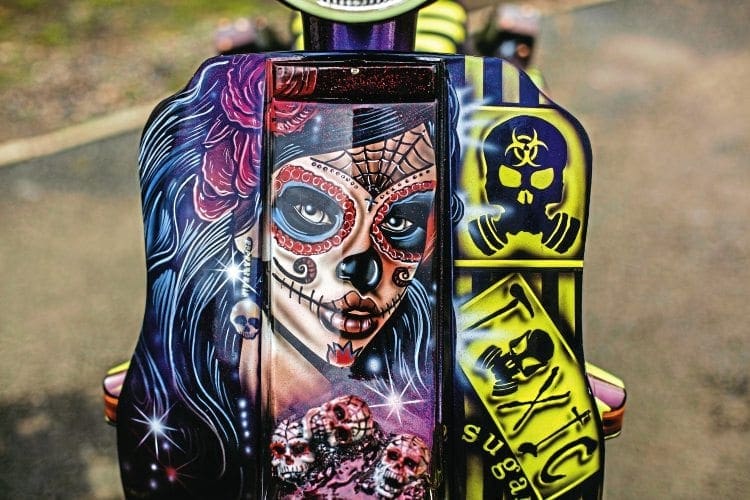
Toxic style
As we all know there’s the usual types of scooters that we’re all familiar with; cut-downs, street-racers, rats, choppers, vintage-classics, full restorations and even steam-punk. So is there room for another interpretation?
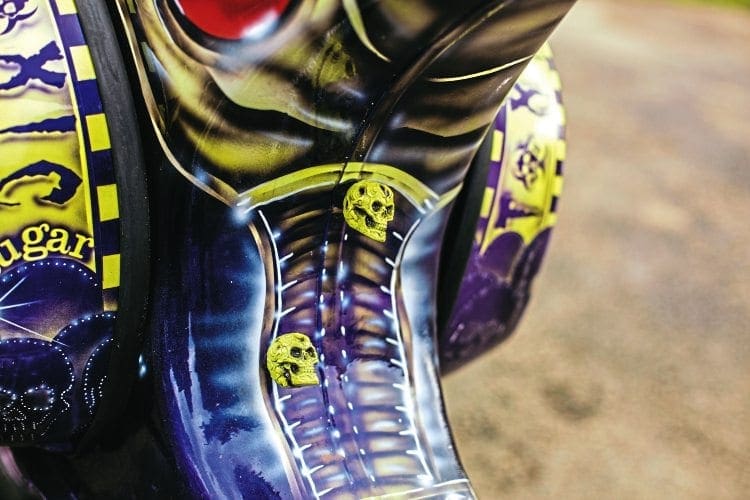
The Toxic theme is described as an industrial new-look to scooters, which makes heavy use of industrial colours and controversial styling. “What’s the point in owing a scooter, which looks exactly the same as the one parked next to it?” Gatch said. “The younger element of the scooter scene are looking for the next thing. I believe they want something that stands out and something that turns heads. It’s about kids having fun in the scooter scene, which I think is in danger of becoming divisive when it should be about building your own scooter and making your own choices. I like it when people take a chance and it’s the honesty of that, which is important.” Since its conception, the Toxic theme has been gathering momentum and now has a growing number of followers and owners of Toxic scooters.
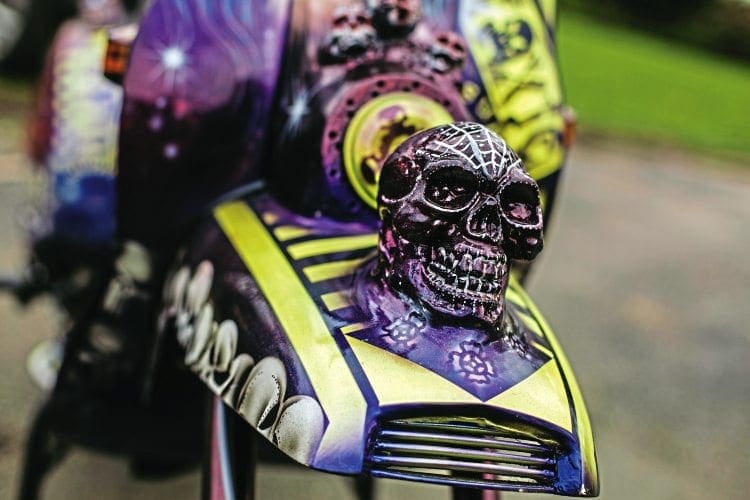
Flagship
Starting life as a Vespa PX125 Toxic 7 is the flagship of the Toxic series, and having rooted out the frame for the scooter Gatch got to grips with it with his angle-grinder.

While this process was taking place Gatch started to develop his ideas, which would later be translated into modifications and additions, which would support his intended artwork. During this part of the development of the scooter Gatch decided that skulls, along with bespoke one-off modifications and additions would play an important part in the overall theme.
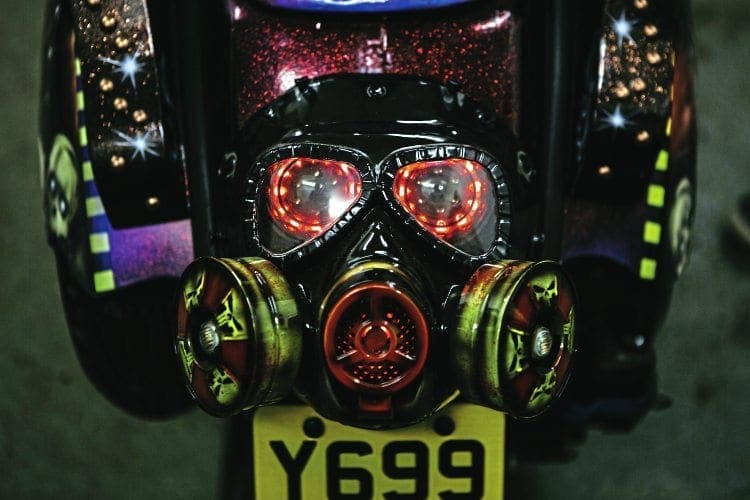
When the frame and body panels were all sorted they were sent off to John Fellows for reinforcement work and other preparations to be made ready for the artwork. In the meantime, Dino got to work developing the engine setup and designing one-off electrical additions and other important modifications, which would be eye-catching and would also support the theme.

“All the embellishments such as the skulls are integral features, which are bolted in, fibre-glassed and chemi-metaled in.” Gatch explained. “The only thing that’ll fall off is the fella riding it!” Dino added.
Free spirit
Gatch explained that the additions on the top of the side panels give a unique Cadillac feel and offer a sense of indulgence, which blends into the theme; while the skull behind the seat and Dino’s gas mask rear light set-up keeps the fundamental element of the Toxic theme pumping. “Everything’s hand-made, nothing’s done over the counter. If I’ve got an idea in my head I’ve got to see it, I can’t go to bed on it if it’s not complete. I would sleep standing up if I could! The plan is in my head and it’s always developing. It’s that ‘divine spark’, it can’t be the same stencils and paint, and it all has to be done by hand.” Gatch said. I asked him to go into a bit more detail about his interpretations. “For me; rule number one is that you have to be a unique free-spirited painter. You have to be someone who’s approachable and is open to alternative suggestions. You can’t be someone who is using the same sheet as the person just down the road. You’ve got to be able to do all these things to make a concept work. It’s the honesty of it that’s the most important thing,” Gatch explained. “You can tell by the way I talk you wouldn’t want to catch me on a full moon!” He laughed.
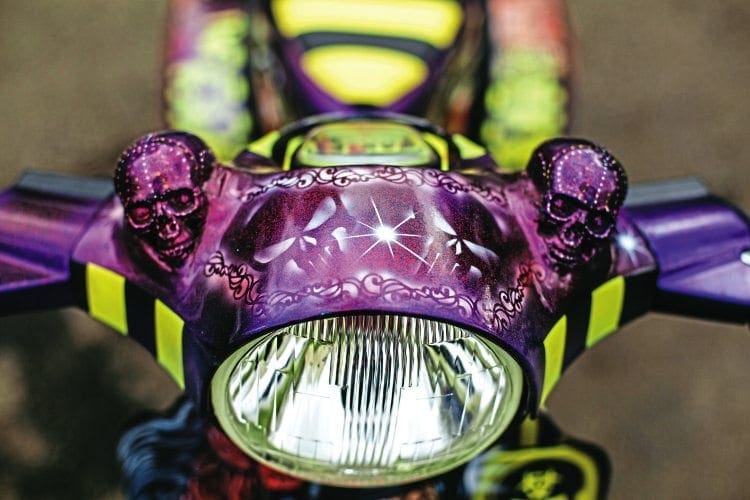
Artwork
Toxic 7’s artwork is born out of Gatch’s interpretation of the Mexican Day of the Dead festival with a Toxic twist.
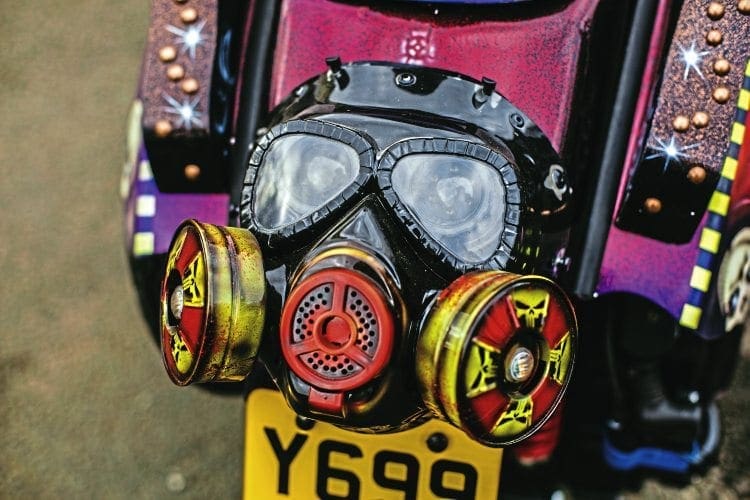
The scooter represents sin, desire and distress. I wanted it to look exotic combined with a sultry and apocalyptic touch; and look sexy.” Gatch explained. “The artwork was applied first, then the ‘trick paint’, the flip-paint and the metalflake. It’s all been done in the reverse order but it maximises the whole effect and draws the onlooker’s eye to the whole appearance of the scooter.”

On the main portion of the horncasting and legshields the sultry eyes of the Sugar Skull appear to be following your every move. On the spare wheel sidepanel she embraces death, on the engine sidepanel she embraces her own mortality and the way that the artwork has been applied gives an impression of an extra depth, which grows deeper and deeper the more you look at it.
Engineering & fabrications
The 6in extended Lambretta forks sits the back end of the scooter down and the scooter runs on a DR 177 kit, which is supported by a standard 20mm carb and a Scorpion exhaust. Dino’s fabricated neat indicators onto the side of the electrics box behind the legshields, and his fantastic one-off fabricated gas mask rear light and indicator set-up is superb and fully functional. He also worked tirelessly to get the ‘Toxic’ Lambretta speedo into the PX headset.
Custom
Dino will soon be showing Toxic 7 on the custom show circuit and whatever you make of it, you’ll be drawn to the spectacle of it. You probably won’t see Gatch at the custom show but he’ll be there; somewhere…

MAN & MACHINE
Name: Dean Child (Dino)
Job: Full time scooter mechanic with a background in engineering.
Scooter club & town: King’s Horbury.
How and when did you first become interested in scooters: When I was about 15 years old and my older friends had them.
What was your first scooter: TV 175. Smashed it up for the fields (I know). P 200e on the road.
What is your favourite scooter model: I like them all, no particular style.
What is your favourite style of custom scooter: Just like the thoughts and imagination that goes into some machines.
Funniest experience with a scooter: Just rebuilt my GTR and setting off backwards hitting ‘the crown jewels’ on the headset! (Woodruff key sheared and it ran backwards).
What’s the furthest you’ve ever ridden on a scooter: Probably Bridlington.
What do you like about rallies/events: Music and meeting old and new friends.
What do you dislike about rallies/events: How people dislike certain scooters. A scooter is what it is and if people can’t afford a Lambretta and get an AJS and still ride, good on them.
What’s your favourite Scootering magazine feature: True stories of people’s adventures.
Your favourite custom scooter of all time: ‘Enola Gay’.
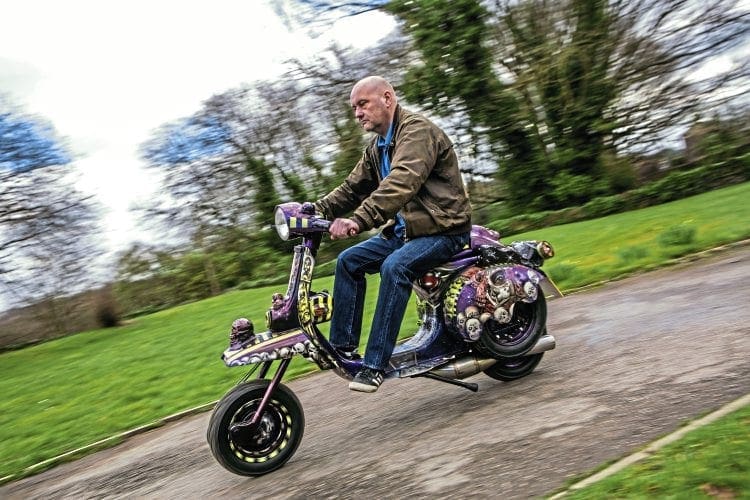
Name of scooter: Toxic 7
Scooter model: PX 125
Time to build: Three months by myself.
Any specialised parts or frame mods: Where do I start? Gas mask back light with LEDs, extended and modified Lambretta forks to fit a Vespa. Lambretta speedo and mudguard modified to fit a Vespa. Headset mounted kill switch. One-off drinks tray and hand-made indicators. Skulls and more skulls. Skulls as petrol tap and choke lever. One-off horncast. Car horn moulded into horncast. Billet levers. Billet grips. Billet kick start. Cadillac fins by Gatch. Frame and panels shaped by Gatch.
Engine kit: DR 177. Exhaust: Scorpion.
Porting work by: Me.
Describe engine performance, power delivery and scooter handling: Reliable. Handling?! Erm… well, interesting.
What was the hardest part of the project: All of it. It was a labour of love. Nothing went to plan.
Do you have any advice or tech tips for anyone starting a project: Dry build before painting.
Is there anything still to add to the scoot: A more comfortable seat, which is sciatica friendly!
In hindsight, is there anything you would have done differently: Everything! I got a fully painted never assembled scooter from Gatch. Nothing fitted together, a complete mismatch from start to finish!
Is there anyone you wish to thank: Gatch. Buzzsolomoto. VE. H&P Services. RPM scooters. Tony Archer. My ever suffering wife, Tracy. My good team of mates (you know who you are). ‘Strongbow’ for inspiration! Ian Bagot for ‘One Song’.
TOXIC 7 – THE STAGES
Stage 1: Found in its scrap and junk stage from parts in Gatch’s garage and parts obtained from parts fairs.
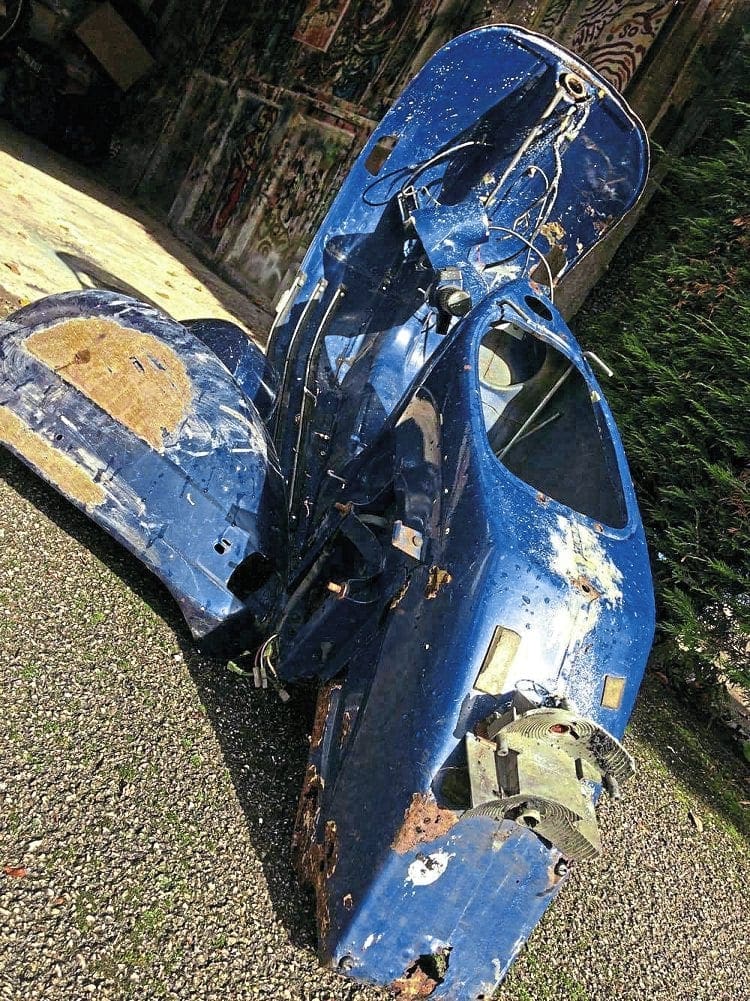
Stage 2: Dry build – essential to check all the parts fit together! (“In an ideal world.” Quote: Dino).
Stage 3: Extended dry build to strengthen and where any weaknesses are found, weld is applied.
Stage 4: Sanded back to the coarse metal, self-etching primer applied, any dents and scratches filled and then basic primer applied to neutralise and expose any smaller imperfections.
Stage 5: White primer coat.
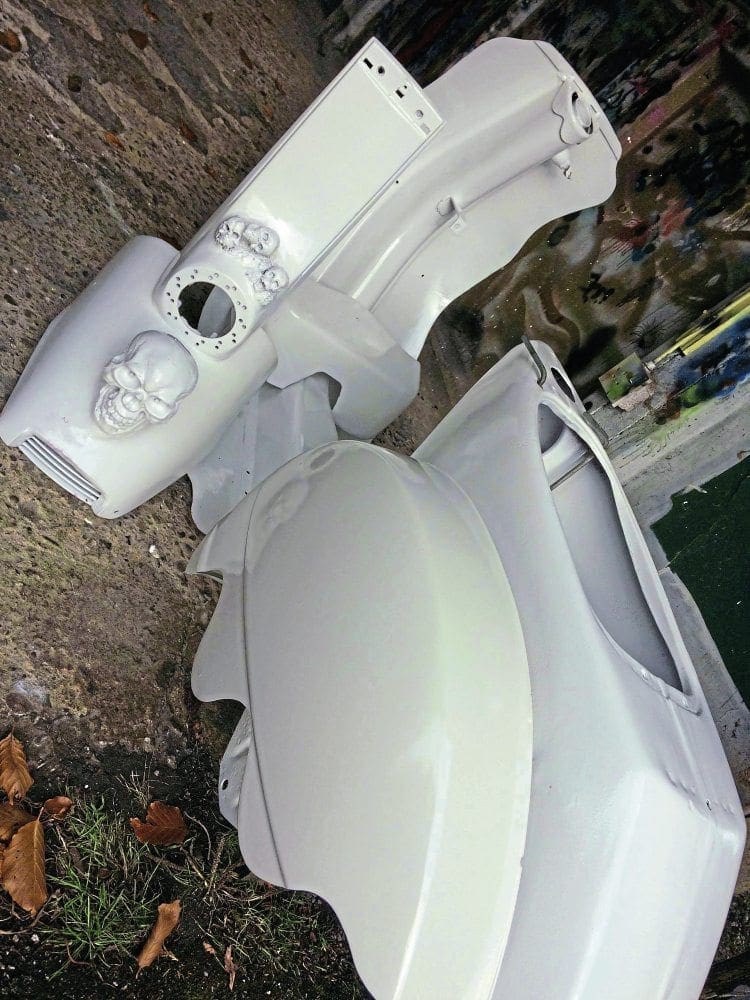
Stage 6: Artwork time and then lacquer.

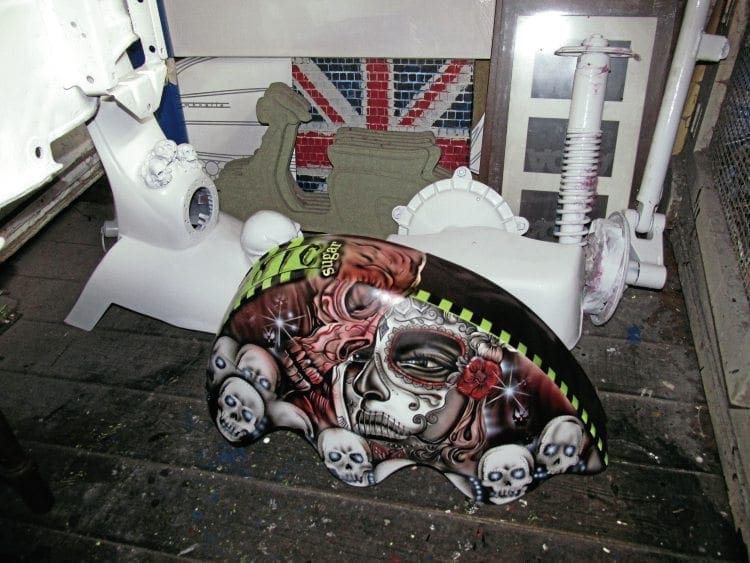
Stage 7: Bodywork to Dino for engine work, mechanics, electrics and rebuild (and all the anxieties that come in between).
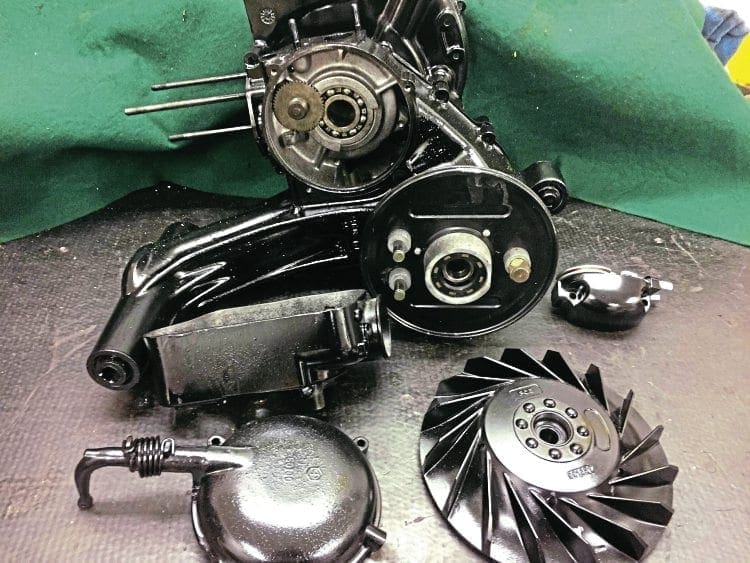
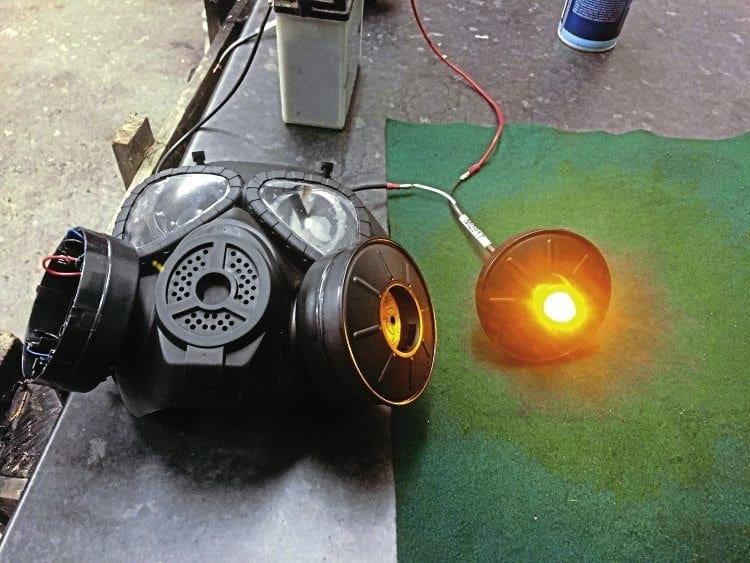

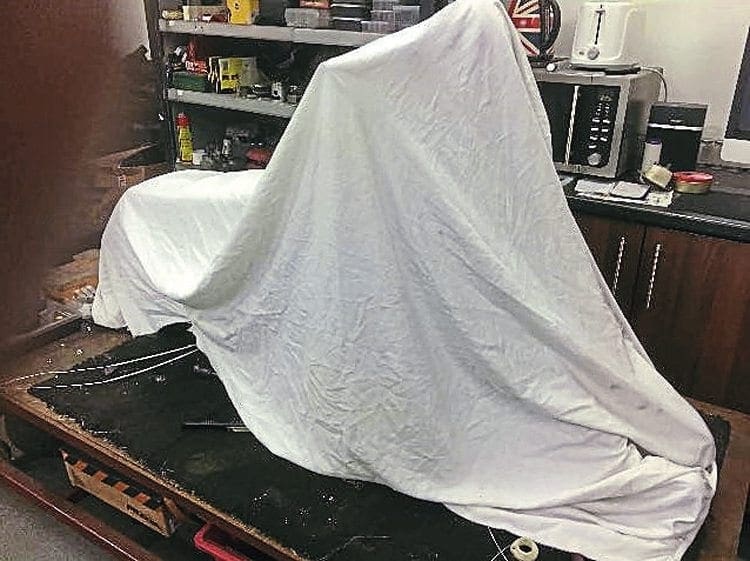
Words: Stu Smith
Photographs: Gary Chapman

